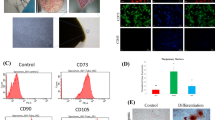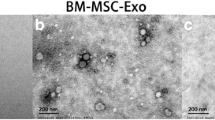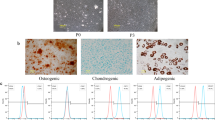Abstract
Intervertebral disc regeneration (IDR) cell therapies aim to regenerate the disc's depleted IVD cells. As an outcome, encouraging the transplanted cells' migration towards the site of damage is critical. It was determined that umbilical cord mesenchymal stem cells (UC-MSCs) labelled with Fe3O4@SiO2 coated polyetherimide (PEI) nanomaterials (PEI/Fe3O4@SiO2 NMs) had a repair effect on degenerative disc disease in the rat caudal vertebral. To understand more about the impact of nanomaterials on UC-MSCs, we characterized UC-MSCs labelled with PEI/Fe3O4@SiO2 NMs and tested whether UC-MSCs could repair IDR in animals. We found UC-MSCs migration was aided by the expressions of CXCR4 in the PEI/Fe3O4@SiO2-labeled UC-MSCs group, which also had improved disc height and tissue performance structure and a more significant ratio of transplanted cells. This treatment also triggered significantly enhanced IVD regeneration, as supported by higher levels of ACAN expressions, type II collagen expression, and Sox-9 expression, as well as lower levels of Il-1β, Tnf-α, and Mmp-13 at both protein levels and mRNA than the unlabeled groups. We exhibited that systemic distribution of UC-MSCs labelled with the PEI/Fe3O4@SiO2 NMs could be a suitable procedure for speeding up and enhancing clinically useful UC-MSCs therapy for IDR.












Similar content being viewed by others
References
M. Nagae, T. Ikeda, Y. Mikami, H. Hase, H. Ozawa, K.-I. Matsuda, H. Sakamoto, Y. Tabata, M. Kawata, and T. Kubo (2007). Intervertebral disc regeneration using platelet-rich plasma and biodegradable gelatin hydrogel microspheres. Tissue Eng. 13, 147–158.
S. C. W. Chan and B. Gantenbein-Ritter (2012). Intervertebral disc regeneration or repair with biomaterials and stem cell therapy-feasible or fiction? Swiss Med Wkly. https://doi.org/10.4414/smw.2012.13598.
G. Vadalà, F. Russo, G. Pattappa, D. Schiuma, M. Peroglio, L. M. Benneker, S. Grad, M. Alini, and V. Denaro (2013). The transpedicular approach as an alternative route for intervertebral disc regeneration. Spine (Phila. Pa. 1976) 38, E319–E324.
R. J. W. Hoogendoorn, Z. F. Lu, R. J. Kroeze, R. A. Bank, P. I. Wuisman, and M. N. Helder (2008). Adipose stem cells for intervertebral disc regeneration: current status and concepts for the future. J. Cell. Mol. Med. 12, 2205–2216.
Y.-C. Huang, J. P. G. Urban, and K. D. K. Luk (2014). Intervertebral disc regeneration: do nutrients lead the way? Nat. Rev. Rheumatol. 10, 561–566.
G. Vadalà, F. Russo, L. Ambrosio, M. Loppini, and V. Denaro (2016). Stem cells sources for intervertebral disc regeneration. World J. Stem Cells 8, 185.
R. D. Bowles and L. A. Setton (2017). Biomaterials for intervertebral disc regeneration and repair. Biomaterials 129, 54–67.
M. W. Kroeber, F. Unglaub, H. Wang, C. Schmid, M. Thomsen, A. Nerlich, and W. Richter (2002). New in vivo animal model to create intervertebral disc degeneration and to investigate the effects of therapeutic strategies to stimulate disc regeneration. Spine (Phila. Pa. 1976) 27, 2684–2690.
D. Sakai and G. B. J. Andersson (2015). Stem cell therapy for intervertebral disc regeneration: obstacles and solutions. Nat. Rev. Rheumatol. 11, 243–256.
Y.-C. Huang, V. Y. L. Leung, W. W. Lu, and K. D. K. Luk (2013). The effects of microenvironment in mesenchymal stem cell–based regeneration of intervertebral disc. Spine J. 13, 352–362.
V. Y. L. Leung, D. M. K. Aladin, F. Lv, V. Tam, Y. Sun, R. Y. C. Lau, S. Hung, A. H. W. Ngan, B. Tang, and C. T. Lim (2014). Mesenchymal stem cells reduce intervertebral disc fibrosis and facilitate repair. Stem Cells 32, 2164–2177.
J. Ying, Z. Han, Y. Zeng, Y. Du, S. Pei, L. Su, D. Ruan, and C. Chen (2019). Evaluation of intervertebral disc regeneration with injection of mesenchymal stem cells encapsulated in PEGDA-microcryogel delivery system using quantitative T2 map**: a study in canines. Am. J. Transl. Res. 11, 2028.
S. M. Richardson, J. A. Hoyland, R. Mobasheri, C. Csaki, M. Shakibaei, and A. Mobasheri (2010). Mesenchymal stem cells in regenerative medicine: opportunities and challenges for articular cartilage and intervertebral disc tissue engineering. J. Cell. Physiol. 222, 23–32.
F. Yang, V. Y. L. Leung, K. D. K. Luk, D. Chan, and K. M. C. Cheung (2009). Mesenchymal stem cells arrest intervertebral disc degeneration through chondrocytic differentiation and stimulation of endogenous cells. Mol. Ther. 17, 1959–1966.
F. Mwale, H. T. Wang, P. Roughley, J. Antoniou, and L. Haglund (2014). Link N and mesenchymal stem cells can induce regeneration of the early degenerate intervertebral disc. Tissue Eng. Part A 20, 2942–2949.
G. Vadalà, F. Russo, L. Ambrosio, R. Papalia, and V. Denaro (2016). Mesenchymal stem cells for intervertebral disc regeneration. J. Biol. Regul. Homeost. Agents 30, 173–179.
F. Cai, X.-T. Wu, X.-H. **: a study in rabbits. Int. Orthop. 39, 149–159.
Y. Tao, C. Liang, H. Li, Y. Zhang, F. Li, G. Chen, and Q. Chen (2013). Potential of co-culture of nucleus pulposus mesenchymal stem cells and nucleus pulposus cells in hyperosmotic microenvironment for intervertebral disc regeneration. Cell Biol. Int. 37, 826–834.
D. Sakai, J. Mochida, Y. Yamamoto, T. Nomura, M. Okuma, K. Nishimura, T. Nakai, K. Ando, and T. Hotta (2003). Transplantation of mesenchymal stem cells embedded in Atelocollagen® gel to the intervertebral disc: a potential therapeutic model for disc degeneration. Biomaterials 24, 3531–3541.
C. C. Shu, M. M. Smith, S. M. Smith, A. J. Dart, C. B. Little, and J. Melrose (2017). A histopathological scheme for the quantitative scoring of intervertebral disc degeneration and the therapeutic utility of adult mesenchymal stem cells for intervertebral disc regeneration. Int. J. Mol. Sci. 18, 1049.
C. Cunha, C. R. Almeida, M. I. Almeida, A. M. Silva, M. Molinos, S. Lamas, C. L. Pereira, G. Q. Teixeira, A. T. Monteiro, and S. G. Santos (2017). Systemic delivery of bone marrow mesenchymal stem cells for in situ intervertebral disc regeneration. Stem Cells Transl. Med. 6, 1029–1039.
E.-K. Shim, J.-S. Lee, D.-E. Kim, S. K. Kim, B.-J. Jung, E.-Y. Choi, and C.-S. Kim (2016). Autogenous mesenchymal stem cells from the vertebral body enhance intervertebral disc regeneration via paracrine interaction: an in vitro pilot study. Cell Transplant. 25, 1819–1832.
F. Ehlicke, D. Freimark, B. Heil, A. Dorresteijn, and P. Czermak (2010). Intervertebral disc regeneration: influence of growth factors on differentiation of human mesenchymal stem cells (hMSC). Int. J. Artif. Organs 33, 244–252.
F. Migliorini, B. Rath, M. Tingart, A. Baroncini, V. Quack, and J. Eschweiler (2019). Autogenic mesenchymal stem cells for intervertebral disc regeneration. Int. Orthop. 43, 1027–1036.
W.-H. Chen, H.-Y. Liu, W.-C. Lo, S.-C. Wu, C.-H. Chi, H.-Y. Chang, S.-H. Hsiao, C.-H. Wu, W.-T. Chiu, and B.-J. Chen (2009). Intervertebral disc regeneration in an ex vivo culture system using mesenchymal stem cells and platelet-rich plasma. Biomaterials 30, 5523–5533.
A. Wei, B. Shen, L. Williams, and A. Diwan (2014). Mesenchymal stem cells: potential application in intervertebral disc regeneration. Transl. Pediatr. 3, 71.
S. M. Richardson, G. Kalamegam, P. N. Pushparaj, C. Matta, A. Memic, A. Khademhosseini, R. Mobasheri, F. L. Poletti, J. A. Hoyland, and A. Mobasheri (2016). Mesenchymal stem cells in regenerative medicine: focus on articular cartilage and intervertebral disc regeneration. Methods 99, 69–80.
B. Choi and S.-H. Lee (2018). Nano/micro-assisted regenerative medicine. Int. J. Mol. Sci. 19, 2187.
R. M. Samsonraj, M. Raghunath, V. Nurcombe, J. H. Hui, A. J. van Wijnen, and S. M. Cool (2017). Concise review: multifaceted characterization of human mesenchymal stem cells for use in regenerative medicine. Stem Cells Transl. Med. 6, 2173–2185.
E. I. Medina-Reyes, D. Garcia-Viacobo, F. A. Carrero-Martinez, and Y. I. Chirino (2017). Applications and risks of nanomaterials used in regenerative medicine, delivery systems, theranostics, and therapy. Crit. Rev. Ther. Drug Carr. Syst. 34, 35.
X. Liu, Z. Yang, J. Sun, T. Ma, F. Hua, and Z. Shen (2019). A brief review of cytotoxicity of nanoparticles on mesenchymal stem cells in regenerative medicine. Int. J. Nanomed. 14, 3875–3892. https://doi.org/10.2147/IJN.S205574.
F. Menaa, A. Abdelghani, and B. Menaa (2015). Graphene nanomaterials as biocompatible and conductive scaffolds for stem cells: impact for tissue engineering and regenerative medicine. J. Tissue Eng. Regen. Med. 9, 1321–1338.
N. Al-Harbi, H. Mohammed, Y. Al-Hadeethi, A. S. Bakry, A. Umar, M. A. Hussein, M. A. Abbassy, K. G. Vaidya, G. Al Berakdar, and E. M. Mkawi (2021). Silica-based bioactive glasses and their applications in hard tissue regeneration: a review. Pharmaceuticals 14, 75.
M. A. Elnaggar and Y. K. Joung, Tissue-inspired interfacial coatings for regenerative medicine, in H. Chun, K. Park, C. H. Kim, and G. Khang (eds.), Novel Biomaterials for Regenerative Medicine (Springer, Singapore, 2018), pp. 415–420.
N. R. Richbourg, N. A. Peppas, and V. I. Sikavitsas (2019). Tuning the biomimetic behavior of scaffolds for regenerative medicine through surface modifications. J. Tissue Eng. Regen. Med. 13, 1275–1293.
A. M. Brokesh and A. K. Gaharwar (2020). Inorganic biomaterials for regenerative medicine. ACS Appl. Mater. Interfaces. 12, 5319–5344.
N. Sabziparvar, Y. Saeedi, M. Nouri, A. S. Najafi-Bozorgi, E. Alizadeh, F. Attar, K. Akhtari, S. E. Mousavi, and M. Falahati (2018). Investigating the interaction of silicon dioxide nanoparticles with human hemoglobin and lymphocyte cells by biophysical, computational, and cellular studies. J. Phys. Chem. B 122, 4278–4288. https://doi.org/10.1021/acs.jpcb.8b00193.
Z. Qiu, J. Wang, K. Yang, J. Guo, W. Wang, R. Pan, and G. Wu (2017). Simultaneous enhancements of mechanical properties and hydrophilic properties of polypropylene via nano-silicon dioxide modified by polydopamine. J Appl Polym Sci. https://doi.org/10.1002/app.45004.
S. Lee, J. M. Kim, C. Kim, H. Kim, H. J. Kang, M.-W. Ha, and H. J. Kim (2018). Densification of silicon dioxide formed by plasma-enhanced atomic layer deposition on 4H-silicon carbide using argon post-deposition annealing. Ceram. Int. 44, 13565–13571.
L. Liu, Y. Lei, Z. Zhang, J. Liu, S. Lv, and Z. Guo (2020). Fabrication of PDA@ SiO2@ rGO/PDMS dielectric elastomer composites with good electromechanical properties. React. Funct. Polym. 154, 104656.
G. Jiao, X. He, X. Li, J. Qiu, H. Xu, N. Zhang, and S. Liu (2015). Limitations of MTT and CCK-8 assay for evaluation of graphene cytotoxicity. RSC Adv. 5, 53240–53244. https://doi.org/10.1039/C5RA08958A.
L. Cai, X. Qin, Z. Xu, Y. Song, H. Jiang, Y. Wu, H. Ruan, and J. Chen (2019). Comparison of cytotoxicity evaluation of anticancer drugs between real-time cell analysis and CCK-8 method. ACS Omega 4, 12036–12042. https://doi.org/10.1021/acsomega.9b01142.
F. Tian, Y. Ling, Y. Chen, and Z. Wang (2017). Effects of CCK-8 and cystathionine γ-lyase/hydrogen sulfide system on acute lung injury in rats. Inflammation 40, 174–183. https://doi.org/10.1007/s10753-016-0466-4.
F. Tramer, T. Da Ros, and S. Passamonti (2012). Screening of fullerene toxicity by hemolysis assay. Methods Mol. Biol. 926, 203–217. https://doi.org/10.1007/978-1-62703-002-1_15.
M. K. M. Subarkhan and R. Ramesh (2016). Ruthenium(II) arene complexes containing benzhydrazone ligands: synthesis, structure and antiproliferative activity. Inorg. Chem. Front. 3, 1245–1255. https://doi.org/10.1039/c6qi00197a.
D. Fischer, Y. Li, B. Ahlemeyer, J. Krieglstein, and T. Kissel (2003). In vitro cytotoxicity testing of polycations: influence of polymer structure on cell viability and hemolysis. Biomaterials 24, 1121–1131. https://doi.org/10.1016/S0142-9612(02)00445-3.
M. K. Mohamed Subarkhan, L. Ren, B. **e, C. Chen, Y. Wang, and H. Wang (2019). Novel tetranuclear ruthenium(II) arene complexes showing potent cytotoxic and antimetastatic activity as well as low toxicity in vivo. Eur J Med Chem. https://doi.org/10.1016/j.ejmech.2019.06.061.
W. W. Hom, M. Tschopp, H. A. Lin, P. Nasser, D. M. Laudier, A. C. Hecht, S. B. Nicoll, and J. C. Iatridis (2019). Composite biomaterial repair strategy to restore biomechanical function and reduce herniation risk in an ex vivo large animal model of intervertebral disc herniation with varying injury severity. PLoS ONE 14, e0217357. https://doi.org/10.1371/journal.pone.0217357.
H. Jia, X. Zhang, X. Zeng, R. Cai, Z. Wang, Y. Yuan, and T. Yue (2021). Construction of silver nanoparticles anchored flower-like magnetic Fe3O4@SiO2@MnO2 hybrids with antibacterial and wound healing activity. Appl. Surf. Sci. 567, 150797. https://doi.org/10.1016/j.apsusc.2021.150797.
H. Li, S. Li, Z. Li, Y. Zhu, and H. Wang (2017). Polysulfone/SiO2 hybrid shell microcapsules synthesized by the combination of pickering emulsification and the solvent evaporation technique and their application in self-lubricating composites. Langmuir 33, 14149–14155. https://doi.org/10.1021/acs.langmuir.7b03370.
Y. Wang, K. Bi, J. Shu, X. Liu, J. Xu, and G. Deng (2019). Ultrasound-controlled DOX-SiO2 nanocomposites enhance the antitumour efficacy and attenuate the toxicity of doxorubicin. Nanoscale 11, 4210–4218. https://doi.org/10.1039/C8NR08497A.
Z. Long, S. Shen, Y. Lu, W. Lan, J. Chen, and H. Qiu (2019). Monodisperse core-shell-structured SiO2@Gd2O3:Eu3+@SiO2@MIP nanospheres for specific identification and fluorescent determination of carbaryl in green tea. Anal. Bioanal. Chem. 411, 4221–4229. https://doi.org/10.1007/s00216-019-01902-2.
Funding
This research did not receive any specific grant from funding agencies in the public, commercial, or not-for-profit sectors.
Author information
Authors and Affiliations
Corresponding author
Ethics declarations
Conflict of interest
The authors declare no potential conflicts of interest.
Additional information
Publisher's Note
Springer Nature remains neutral with regard to jurisdictional claims in published maps and institutional affiliations.
Rights and permissions
About this article
Cite this article
Tian, L., Wang, T., Li, G. et al. Enhancing Cell Migration on Polyetherimide-Grafted Fe3O4@SiO2-Labeled Umbilical Cord-Derived Mesenchymal Stem Cells Arrests in Intervertebral Disc Regeneration. J Clust Sci 34, 599–611 (2023). https://doi.org/10.1007/s10876-022-02238-1
Received:
Accepted:
Published:
Issue Date:
DOI: https://doi.org/10.1007/s10876-022-02238-1




